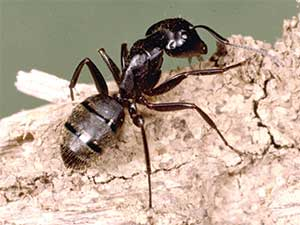Carpenter Ants

Carpenter ants are relatively common in Kansas. They get their name because they tend to build their nests in wood. Unlike termites, carpenter ants don’t feed on wood; they use it as a place to live. These are the largest ants in Kansas, with adults ranging in size from ¼” for workers to ¾” for queens, depending on the ant species. They range in color from reddish brown to black, with some species having red fronts and black rears. The easiest way to identify these ants is by the ring of tiny hairs at the tip of the abdomen. Carpenter ants will burrow into soft, moist wood to establish their nests.
They prefer wood that has already started to decay; however, they will also excavate into perfectly sound wood. In houses, these ants build “galleries” to rear young. These galleries are formed without regard for the grain of the wood and tend to follow the softer parts of the wood. An indication you have carpenter ants issues is the sawdust they eject from their galleries. Houses near wooded areas are more likely to have problems with carpenter ants than those away from trees. In trees, carpenter ants are taking advantage of wood that has already started to decay. They tend to be a symptom of an already existing issue in a tree rather than being the cause of the damage.
The first step to controlling the ants in a home is finding their nest. The first places to inspect are areas affected by water seepage, such as window sills, roofs, porches, posts, columns, and rotten stumps, logs, or trees nearby. Apply pyrethroid products directly to the nest according to the label requirements to eliminate the parent colony. You should also apply spot treatments and insecticide spray around the perimeter of buildings to prevent a new colony from infesting the area. Be sure to fix the issue that also caused the rotten or damp wood.

Have questions? Contact our office where our Horticulture Extension Agent will assist you with questions.
Phone: (316) 321-9660
Email: callae@ksu.edu